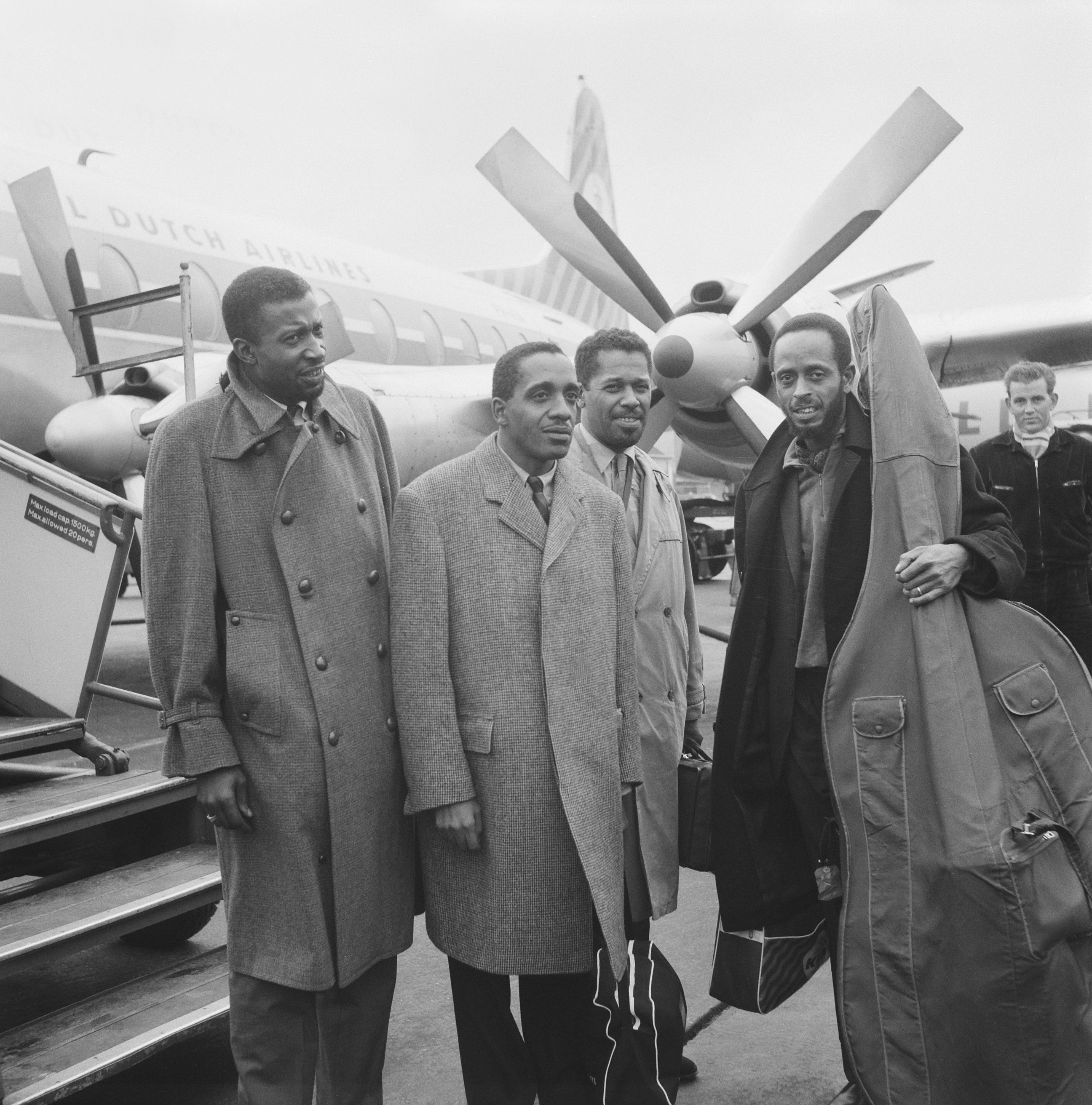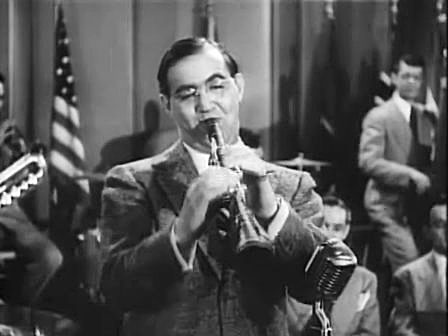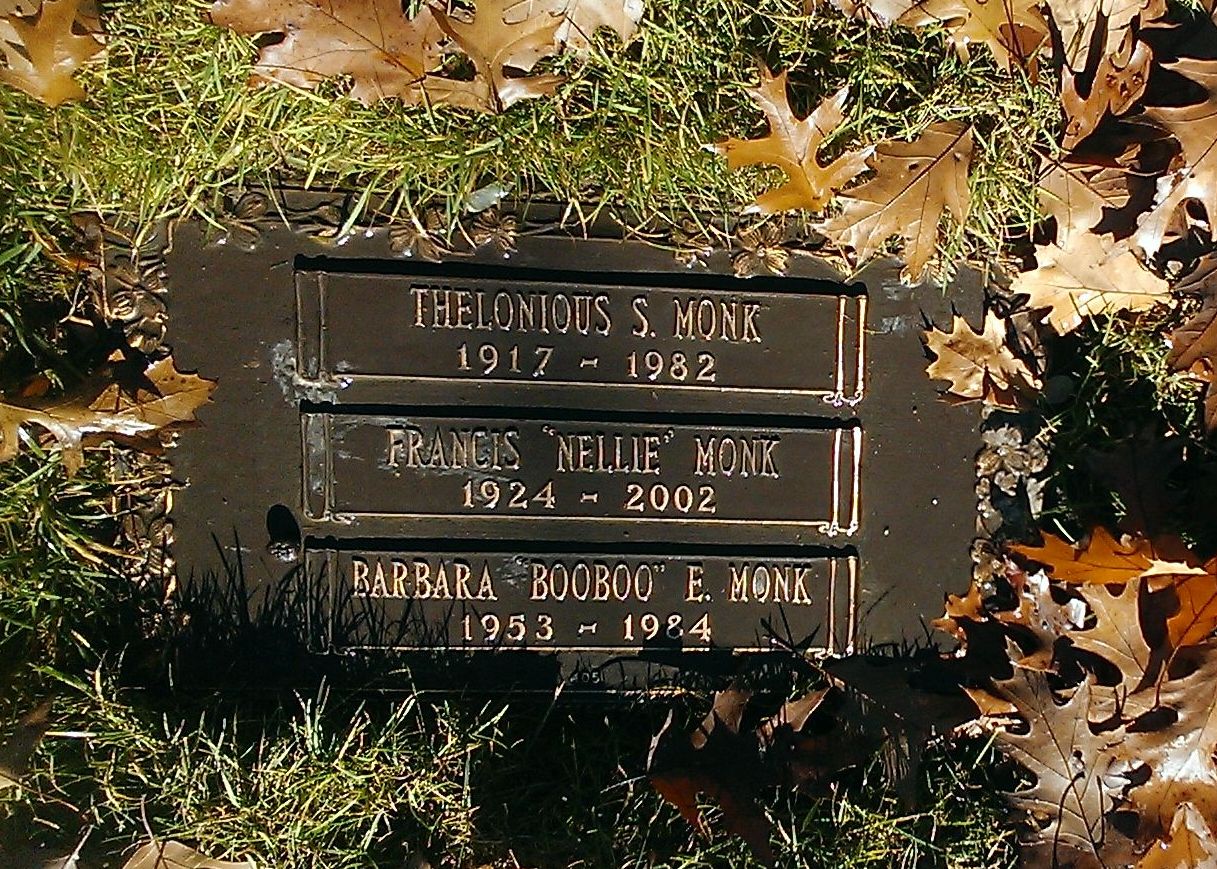|
The Modern Jazz Quartet
The Modern Jazz Quartet (MJQ) was a jazz combo established in 1952 that played music influenced by classical, cool jazz, blues and bebop. The Quartet consisted of John Lewis (piano), Milt Jackson (vibraphone), Percy Heath (double bass), and various drummers, most notably Kenny Clarke (from 1952 to 1955) and Connie Kay (from 1955 to 1994). The group grew out of the rhythm section of Dizzy Gillespie's big band from 1946 to 1948, which consisted of Lewis, Jackson, and Clarke along with bassist Ray Brown. They recorded as the Milt Jackson Quartet in 1951 and Brown left the group, being replaced on bass by Heath. During the early-to-mid-1950s they became the Modern Jazz Quartet, Lewis became the group's musical director, and they made several recordings with Prestige Records, including the original versions of their two best-known compositions, Lewis's " Django" and Jackson's " Bags' Groove". Clarke left the group in 1955 and was replaced as drummer by Kay, and in 1956 they moved ... [...More Info...] [...Related Items...] OR: [Wikipedia] [Google] [Baidu] |
Jazz
Jazz is a music genre that originated in the African-American communities of New Orleans, Louisiana, in the late 19th and early 20th centuries. Its roots are in blues, ragtime, European harmony, African rhythmic rituals, spirituals, hymns, marches, vaudeville song, and dance music. Since the 1920s Jazz Age, it has been recognized as a major form of musical expression in traditional and popular music. Jazz is characterized by swing and blue notes, complex chords, call and response vocals, polyrhythms and improvisation. As jazz spread around the world, it drew on national, regional, and local musical cultures, which gave rise to different styles. New Orleans jazz began in the early 1910s, combining earlier brass band marches, French quadrilles, biguine, ragtime and blues with collective polyphonic improvisation. However, jazz did not begin as a single musical tradition in New Orleans or elsewhere. In the 1930s, arranged dance-oriented swing big bands, ... [...More Info...] [...Related Items...] OR: [Wikipedia] [Google] [Baidu] |
Blues
Blues is a music genre and musical form that originated among African Americans in the Deep South of the United States around the 1860s. Blues has incorporated spiritual (music), spirituals, work songs, field hollers, Ring shout, shouts, chants, and rhymed simple narrative ballad (music), ballads from the African-American culture. The blues form is ubiquitous in jazz, rhythm and blues, and rock and roll, and is characterized by the Call and response (music), call-and-response pattern, the blues scale, and specific chord progressions, of which the twelve-bar blues is the most common. Blue notes (or "worried notes"), usually thirds, fifths or sevenths flattened in Pitch (music), pitch, are also an essential part of the sound. Blues shuffle note, shuffles or walking bass reinforce the trance-like rhythm and form a repetitive effect known as the groove (popular music), groove. Blues music is characterized by its lyrics, Bassline, bass lines, and Instrumentation (music), instrumen ... [...More Info...] [...Related Items...] OR: [Wikipedia] [Google] [Baidu] |
DownBeat
''DownBeat'' (styled in all caps) is an American music magazine devoted to "jazz, blues and beyond", the last word indicating its expansion beyond the jazz realm that it covered exclusively in previous years. The publication was established in 1934 in Chicago, Illinois. It is named after the " downbeat" in music, also called "beat one", or the first beat of a musical measure. ''DownBeat'' publishes results of annual surveys of both its readers and critics in a variety of categories. The ''DownBeat'' Jazz Hall of Fame includes winners from both the readers' and critics' poll. The results of the readers' poll are published in the December issue, those of the critics' poll in the August issue. Since 2008, the Hall of Fame also includes winners from the Veterans Committee. Popular features of ''DownBeat'' magazine include its "Reviews" section where jazz critics, using a '1-Star to 5-Star' maximum rating system, rate the latest musical recordings, vintage recordings, and books; arti ... [...More Info...] [...Related Items...] OR: [Wikipedia] [Google] [Baidu] |
Ella Fitzgerald
Ella Jane Fitzgerald (April25, 1917June15, 1996) was an American singer, songwriter and composer, sometimes referred to as the "First Lady of Song", "Queen of Jazz", and "Lady Ella". She was noted for her purity of tone, impeccable diction, phrasing, timing, Intonation (music), intonation, absolute pitch, and a "horn-like" improvisational ability, particularly in her scat singing. After a tumultuous adolescence, Fitzgerald found stability in musical success with the Chick Webb Orchestra, performing across the country but most often associated with the Savoy Ballroom in Harlem. Her rendition of the nursery rhyme "A-Tisket, A-Tasket" helped boost both her and Webb to national fame. After taking over the band when Webb died, Fitzgerald left it behind in 1942 to start her solo career. Her manager was Moe Gale, co-founder of the Savoy, until she turned the rest of her career over to Norman Granz, who founded Verve Records to produce new records by Fitzgerald. With Verve, she recorded ... [...More Info...] [...Related Items...] OR: [Wikipedia] [Google] [Baidu] |
Dee Gee Records
Dee Gee Records was a jazz record company and independent record label founded in Detroit, Michigan in 1951 by Dizzy Gillespie and Dave Usher. History ''Billboard'' relates that Dee Gee opened for business on April 7, 1951. According to Gillespie, Dee Gee Records was the result of his desire to control his own recorded output. Dave Usher was a 21-year-old fan and friend of Gillespie. Dee Gee Records was based in Detroit where Usher lived, and its sessions were held there, in New York City, and in Chicago. Initial response was encouraging, and within a short time Dee Gee began to record artists other than Gillespie. But over time Usher found it difficult to handle the financial matters of the company, and in 1953 Dee Gee closed, with Gillespie returning to established firms to make his recordings. In 1956 the label and its catalog were acquired by Savoy Records, which has controlled it ever since. Despite Dee Gee's failure, Gillespie and Usher remained lifelong friends; after a br ... [...More Info...] [...Related Items...] OR: [Wikipedia] [Google] [Baidu] |
Benny Goodman
Benjamin David Goodman (May 30, 1909 – June 13, 1986) was an American clarinetist and bandleader, known as the "King of Swing". His orchestra did well commercially. From 1936 until the mid-1940s, Goodman led one of the most popular swing big bands in the United States. His concert at Carnegie Hall in New York City on January 16, 1938, is described by critic Bruce Eder as "the single most important jazz or popular music concert in history: jazz's 'coming out' party to the world of 'respectable' music." Goodman's bands started the careers of many jazz musicians. During an era of racial segregation, he led one of the first integrated jazz groups, his trio and quartet. He continued performing until the end of his life while pursuing an interest in classical music. Early years Goodman was the ninth of twelve children born to poor Jewish emigrants from the Russian Empire. His father, David Goodman, came to the United States in 1892 from Warsaw in partitioned Poland and becam ... [...More Info...] [...Related Items...] OR: [Wikipedia] [Google] [Baidu] |
Entr'acte
(or , ;Since 1932–35 the recommends this spelling, with no apostrophe, so historical, ceremonial and traditional uses (such as the 1924 René Clair film title) are still spelled . and ', , and ) means 'between the acts'. It can mean a pause between two parts of a stage production, synonymous to an intermission (this is nowadays the more common meaning in French), but it more often (in English) indicates a piece of music performed between acts of a theatrical production. But despite this, an entr'acte is often paired with a longer intermission, as an intermission is usually "between acts." However, there can also be an entr'acte on its own, usually between the two acts without an intermission. In the case of stage musicals, the serves as the overture of act 2 (and sometimes acts 3 and 4, as in ''Carmen''). In films that were meant to be shown with an intermission, there was frequently a specially recorded on the soundtrack between the first and second half of the film, al ... [...More Info...] [...Related Items...] OR: [Wikipedia] [Google] [Baidu] |
Jazz Standard
Jazz standards are musical compositions that are an important part of the musical repertoire of jazz musicians, in that they are widely known, performed, and recorded by jazz musicians, and widely known by listeners. There is no definitive List of jazz standards (other), list of jazz standards, and the list of songs deemed to be standard (music), standards changes over time. Songs included in major fake book publications (lead sheet collections of popular tunes) and jazz reference works offer a rough guide to which songs are considered standards. Not all jazz standards were written by jazz composers. Many are originally Tin Pan Alley popular songs, Broadway theatre, Broadway show tunes or songs from Cinema of the United States, Hollywood musical film, musicals – the Great American Songbook. In Europe, jazz standards and "fake books" may even include some traditional folk songs (such as in Scandinavia) or pieces of a minority ethnic group's music (such as gypsy music ( ... [...More Info...] [...Related Items...] OR: [Wikipedia] [Google] [Baidu] |
Thelonious Monk
Thelonious Sphere Monk ( October 10, 1917 – February 17, 1982) was an American Jazz piano, jazz pianist and composer. He had a unique improvisational style and made numerous contributions to the Jazz standard, standard jazz repertoire, including "'Round Midnight (song), 'Round Midnight", "Blue Monk", "Straight, No Chaser (composition), Straight, No Chaser", "Ruby, My Dear (composition), Ruby, My Dear", "In Walked Bud", and "Well, You Needn't". Monk is the second-most-recorded jazz composer after Duke Ellington. Monk's compositions and improvisations feature consonance and dissonance, dissonances and angular melodic twists, often using flat ninths, flat fifths, unexpected chromatic notes together, low bass notes and stride, and fast whole tone scale, whole tone runs, combining a highly percussive attack with abrupt, dramatic use of switched key releases, silences, and hesitations. Monk's distinct look included suits, hats, and sunglasses. He also had an idiosyncratic habit dur ... [...More Info...] [...Related Items...] OR: [Wikipedia] [Google] [Baidu] |
Counterpoint
In music theory, counterpoint is the relationship of two or more simultaneous musical lines (also called voices) that are harmonically dependent on each other, yet independent in rhythm and melodic contour. The term originates from the Latin ''punctus contra punctum'' meaning "point against point", i.e. "note against note". John Rahn describes counterpoint as follows: Counterpoint has been most commonly identified in the European classical tradition, strongly developing during the Renaissance and in much of the common practice period, especially in the Baroque period. In Western pedagogy, counterpoint is taught through a system of species (see below). There are several different forms of counterpoint, including imitative counterpoint and free counterpoint. Imitative counterpoint involves the repetition of a main melodic idea across different vocal parts, with or without variation. Compositions written in free counterpoint often incorporate non-traditional harmonies and c ... [...More Info...] [...Related Items...] OR: [Wikipedia] [Google] [Baidu] |
Bags' Groove (composition)
"Bags' Groove" is a jazz music composition, composition by Milt Jackson. It was first recorded by the Milt Jackson Quintet on April 7, 1952 for Blue Note Records, later released on ''Wizard of the Vibes''. Lou Donaldson, John Lewis (pianist), John Lewis, Percy Heath and Kenny Clarke were on that date. Next was the Mat Mathews quintet with Herbie Mann (July 6, 1953), Bud Powell (September 1953), Mat Mathews again (September 1, 1953), a bootleg version by the Modern Jazz Quartet (October 31, 1953), the Lighthouse All-Stars (February 25, 1954), bassist Buddy Banks (bassist), Buddy Banks' quartet (with Bob Dorough and Roy Haynes in October 1954) and then Jay Jay Johnson and Kai Winding (December 3, 1954). Other important recordings include those by Ray Bryant, Oscar Peterson, Al Haig, George Russell (composer), George Russell, and Mal Waldron. Perhaps the most famous recording was the one by Miles Davis's quintet in 1954. The recording was released on the 1957 album ''Bags' Groove''. ... [...More Info...] [...Related Items...] OR: [Wikipedia] [Google] [Baidu] |
Django (composition)
"Django" is a 1954 jazz standard written by John Lewis as a tribute to the Belgian-born jazz guitarist Django Reinhardt. It was a signature composition of the Modern Jazz Quartet, of which Lewis was the pianist and musical director. Background and structure Lewis wrote "Django" in 1954 as a tribute to his friend, the Belgian-born jazz guitarist Django Reinhardt, who died the previous year. It begins with a 20-bar theme that was described by Ted Gioia in his book ''The Jazz Standards'' as dirge-like and mournful. The entry for "django" in the original edition of the '' Real Book'' only contained the chord changes for this theme. It is followed by solo sections in modified Thirty-two-bar AABA form, where the first two A sections contain six bars instead of eight, the eight-bar B section contains a pedal point on the tonic, and the final twelve-bar A section contains a boogie bass motif. The solo sections are separated by interludes in double-time derived from the introduc ... [...More Info...] [...Related Items...] OR: [Wikipedia] [Google] [Baidu] |






